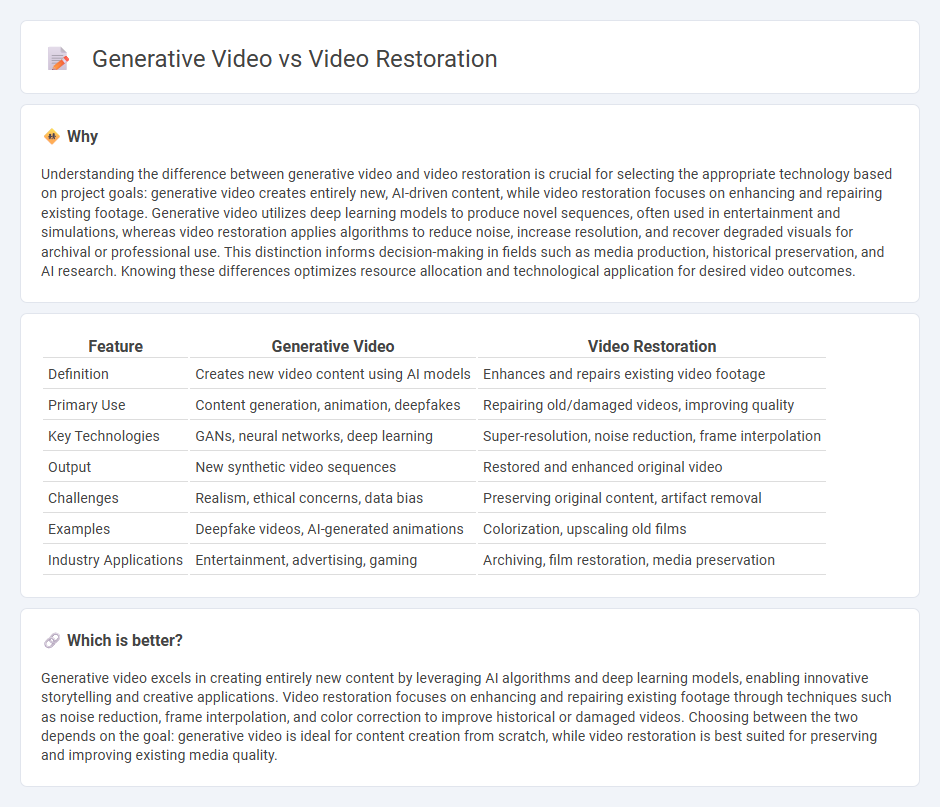
Generative video leverages deep learning algorithms to create entirely new video content from scratch, often using neural networks such as GANs to produce realistic visuals and motions, while video restoration focuses on enhancing and repairing existing footage by removing noise, correcting colors, and filling in damaged frames using advanced image processing techniques. Both technologies harness artificial intelligence to revolutionize digital media production, with generative video enabling creative synthesis and video restoration preserving historical and degraded content. Explore the latest innovations and applications to understand how these technologies transform the future of video technology.
Why it is important
Understanding the difference between generative video and video restoration is crucial for selecting the appropriate technology based on project goals: generative video creates entirely new, AI-driven content, while video restoration focuses on enhancing and repairing existing footage. Generative video utilizes deep learning models to produce novel sequences, often used in entertainment and simulations, whereas video restoration applies algorithms to reduce noise, increase resolution, and recover degraded visuals for archival or professional use. This distinction informs decision-making in fields such as media production, historical preservation, and AI research. Knowing these differences optimizes resource allocation and technological application for desired video outcomes.
Comparison Table
| Feature | Generative Video | Video Restoration |
|---|---|---|
| Definition | Creates new video content using AI models | Enhances and repairs existing video footage |
| Primary Use | Content generation, animation, deepfakes | Repairing old/damaged videos, improving quality |
| Key Technologies | GANs, neural networks, deep learning | Super-resolution, noise reduction, frame interpolation |
| Output | New synthetic video sequences | Restored and enhanced original video |
| Challenges | Realism, ethical concerns, data bias | Preserving original content, artifact removal |
| Examples | Deepfake videos, AI-generated animations | Colorization, upscaling old films |
| Industry Applications | Entertainment, advertising, gaming | Archiving, film restoration, media preservation |
Which is better?
Generative video excels in creating entirely new content by leveraging AI algorithms and deep learning models, enabling innovative storytelling and creative applications. Video restoration focuses on enhancing and repairing existing footage through techniques such as noise reduction, frame interpolation, and color correction to improve historical or damaged videos. Choosing between the two depends on the goal: generative video is ideal for content creation from scratch, while video restoration is best suited for preserving and improving existing media quality.
Connection
Generative video leverages AI algorithms to create new video content by analyzing existing footage, while video restoration enhances and repairs damaged or low-quality videos using machine learning techniques. Both technologies rely on deep neural networks and advanced computer vision models to understand and manipulate visual data at a pixel level. The integration of generative video and video restoration accelerates content creation and preservation, improving video quality and enabling novel media experiences.
Key Terms
Upscaling
Video restoration enhances old or damaged footage by removing artifacts, improving clarity, and recovering lost details through advanced algorithms. Generative video upscaling leverages AI models to increase resolution and create new high-quality frames, generating visually appealing content beyond original limitations. Explore cutting-edge techniques to understand the differences and applications in video enhancement.
Inpainting
Video restoration enhances damaged or degraded footage by using techniques such as inpainting to fill missing or corrupted areas with contextually accurate pixels. Generative video employs AI models to create entirely new frames or sequences, often leveraging inpainting to add or modify content seamlessly within the video. Explore the fundamentals and applications of video inpainting to understand its critical role in both restoration and generative video processes.
Deep Learning
Video restoration utilizes deep learning algorithms to enhance and repair degraded footage by removing noise, correcting color, and filling missing frames. Generative video models leverage neural networks to create entirely new video content or predict future frames, often using techniques like GANs and transformers. Explore more about how deep learning transforms video quality and creation through cutting-edge technologies.
Source and External Links
21 Best Video Restoration Software for 2025 - Curated list of top video restoration tools that fix scratches, enhance colors, and upscale resolution for beginners and professionals alike.
Video Restoration Services: Bringing Your Footage Back to ... - Professional services use advanced technology to restore aging footage with color correction, noise reduction, frame-by-frame repair, and high-definition upscaling for VHS, film, and digital files.
How To Digitally Restore Your Old Home Movies - Step-by-step tutorial demonstrating the use of AVCLabs Video Enhancer AI and FILM9 to clean grain, stabilize video, correct colors, and upscale resolution for old home movies.
 dowidth.com
dowidth.com